September 26, 2008
Air Date: September 26, 2008
FULL SHOW
SEGMENTS
Drill, and Let the Sun Shine
/ Jeff YoungView the page for this story
As Congress tries to wrap up a session dominated by energy and financial woes, two major environmental items emerged: tax credits crucial to wind, solar and other clean energy sources won support; and a moratorium banning most offshore oil drilling came to an end. Living on Earth's Jeff Young explains what that might mean for the country's energy future. (05:00)
Green New Deal
View the page for this story
New York Times columnist Thomas Friedman wants the United States to turn the recent financial crisis into a green opportunity to strengthen America's future. He wrote about his ideas in a new book called "Hot, Flat, and Crowded" and tells Living on Earth host Bruce Gellerman why a global clean energy revolution is imminent. (07:00)
Getting to Know Your Food
View the page for this story
A law that requires food producers to label where meat, veggies and fruit come from goes into effect at the end of September. Meanwhile, the FDA says that labels on food products from genetically modified animals are not necessary. Senior Scientist Urvashi Rangan of Consumers Union talks turkey with host Bruce Gellerman. (05:00)
Defending Coal’s Victims
View the page for this story
This year’s winner of the Heinz Award for the Environment is Thomas FitzGerald. FitzGerald founded the Kentucky Resources Council and, for over 25 years, has worked pro-bono, helping Kentucky residents harmed by coal mining. Fitzgerald talks with host Bruce Gellerman about his work. (05:30)
Your Environmental Road Trip
View the page for this story
Three friends drove to every state in the country to document the quirky things people are doing for the environment. Two of the trio, Mark Dixon and Julie Evans, talk with host Bruce Gellerman about their adventures. (07:15)
The Road to Better Air
/ Sandra LarsonView the page for this story
A greener form of blacktop is in the works. Sandra Larson reports. (01:40)
Scotching the Wind
/ Tom AllanView the page for this story
Even in Europe, there are some places barely touched by time. For example, on the Scottish Isle of Lewis, people speak Gaelic and still stoke home-fires with peat dug from family bogs. But a recent plan to bring a giant windfarm to the island drew fierce opposition from environmentalists and residents who want to preserve the peatlands and their traditional ways of life. Tom Allan reports. (14:40)
Show Credits and Funders
Show Transcript
Host: Bruce Gellerman
Guests: Julie Evans, Mark Dixon, Thomas FitzGerald, Tom Friedman, Mark Nixon, Urvashi Rangan
Reporters: “Tom” William Alan, Jeff Young
(THEME)
GELLERMAN: From Public Radio International -- this is Living on Earth.
(THEME)
GELLERMAN: I’m Bruce Gellerman…
The world economy is tanking, the planet’s population exploding, the earth’s warming. It’s the worst of times - but perhaps the perfect time for a “green New Deal.”
FRIEDMAN: You cannot be a big country without being big in big things, and there's nothing that's going to be bigger than clean tech. This isn't just about electric power, this is about national power.
GELLERMAN: A conversation with New York Times columnist Tom Friedman about a world gone hot, flat and crowded.
Also, “Drill, Baby, Drill!” congress hears the cry.
And what a long, strange trip it’s been - traveling 50 states in search of weird environmental stories.
DIXON: We had to keep all of our garbage with us. We tried to make no more than one shoebox of garbage, per month, across all three of us. It was either garbage or maybe your underwear!
Choose from these stories and more this week on Living on Earth. Stick around!
[MUSIC: Boards Of Canada “Zoetrope” from “In A Beautiful Place Out In The Country” (Warp Records 2000)]
ANNOUNCER: Support for Living on Earth comes from the National Science Foundation and Stonyfield Farm.
Drill, and Let the Sun Shine

Congress shined a bit of light on the solar industry’s future by renewing alternative energy tax incentives. (Photo: Jackie Beck)
[THEME]
GELLERMAN: From the Jennifer and Ted Stanley studios in Somerville, Massachusetts, This is Living on Earth. I’m Bruce Gellerman, in for Steve Curwood.
As if staving off the chaos of economic collapse wasn’t enough, Congress scrambled to deal with two major environmental issues before calling it a session: Renewing tax credits for renewable energies, and deciding the fate of a 30-year offshore drilling ban. Living on Earth's Jeff Young reports on what Congress did and what it didn’t do.
YOUNG: Each year since 1981 congress has renewed the moratorium on offshore drilling. But not this year. Public outrage over high gas prices fueled an aggressive pro-drilling agenda by Congressional Republicans and backed Democratic leaders into a corner. There simply weren’t the votes to keep the moratorium in place. So, at the end of this month most of the US coastline from three miles out will be open for government leases for oil and gas exploration.
It’s a big win for oil drilling advocates like Texas Republican congressman Joe Barton.
BARTON: It is a very significant step and it is probably the most positive result of this congress in any venue.
YOUNG: For California Democratic senator Barbara Boxer, who chairs the senate’s environment committee, it’s something else.
BOXER: It’s a very sad day for the country when we lose the protections in place for so many years.
YOUNG: Politically, Boxer and Barton are poles apart. But they agree that the end of the moratorium does not end the drilling debate. Energy companies say they will need a clear legal framework, and perhaps more incentives, before they lease and explore offshore areas. Dan Naatz of the Independent Petroleum Association of America says he doesn’t expect to see any drilling anytime soon.
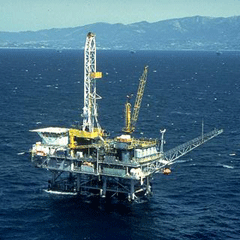
After a 26-year moratorium, Congress puts offshore oil drilling back on the table. (Courtesy of the Department of the Interior)
YOUNG: Sierra Club executive director Carl Pope says the moratorium’s demise means the real drilling debate now awaits the new Congress and president next year.
POPE: Symbolically it’s obviously a blow, substantively it doesn’t mean much because the next administration was always going to decide what happened on the coast. And the next administration will now decide what happens on the coast.
YOUNG: The presidential candidates disagree strongly on drilling. Democratic candidate Barack Obama would consider limited expansion of drilling as part of a broader energy agenda. Republican candidate John McCain strongly supports expanding offshore drilling. Either way, the end of the moratorium means those who favor protecting the coasts, like Senator Barbara Boxer, will be on the defensive.
BOXER: It puts us in a difficult position. But I’ve got to tell you, those of us who favor protecting the moratoria areas are not saying don’t drill anywhere off the coast. There’s lots of areas. So I think once the heat is off this issue and it’s not caught in an election year politics as it is now, I think people will see the wisdom of drilling where it’s appropriate and protecting the coastline where it’s appropriate, and have an energy policy not an Exxon policy.

Congress shined a bit of light on the solar industry’s future by renewing alternative energy tax incentives. (Photo: Jackie Beck)
YOUNG: For weeks congress considered more comprehensive energy measures. But when Wall Street’s financial crisis landed in their laps, lawmakers decided to punt on energy issues.
One energy item does look like it will get over the goal line, though. The Senate finally passed an extension of tax credits crucial to wind, solar and other sources of renewable energy. The tax package encourages energy-efficient homes and appliances and plug-in hybrid electric vehicles. It’s especially good for solar power, extending credits for eight years and greatly increasing benefits for homeowners who go solar. Rhone Resch of the Solar Energy Industries Association says that means renewable energy will continue to be a bright spot in an otherwise gloomy economy.
RESCH: It is going to create over 1.2 million new job starts in the United States and over 230 billion dollars of economic investment. This is just in the solar industry alone. Think about that. It isn’t just about energy independence, it isn’t just about energy security; it’s about the new energy economy.
YOUNG: But the country’s fastest growing source of clean energy, wind power, did not fare so well. The bill only extends the production tax credit for wind projects one year.
That means wind companies could soon be back in the same, uncertain situation next year. So while advocates for renewable energy and offshore drilling reached important milestones, the real story for both is, “to be continued.”
For Living on Earth, I’m Jeff Young in DC.
Related links:
- For details on the clean energy tax credits, check out The Solar Energy Industries Association
- American Wind Energy Association
- The Department of Energy’s Energy Information Administration has background on the offshore drilling moratorium.
- Check out Living on Earth’s coverage of where presidential candidates John McCain and Barack Obama stand on offshore drilling and clean energy
Green New Deal
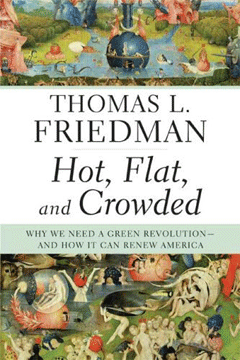
GELLERMAN: Thomas Friedman doesn't need much of an introduction - but we'll give him one anyway.
Tom Friedman is a three time Pulitzer-prize winning columnist for the New York Times, and bestselling author. His latest book is "Hot, Flat, and Crowded: Why We Need a Green Revolution and How it Can Renew America." Friedman says, we face the worst of times, but this could be the perfect time for a New Green Deal:
FRIEDMAN: We have to use this moment to launch the next great global industry. Here we are thinking Bruce about spending $700 billion to bail out our economy, and in my attitude, when the IT bubble burst, well it burst, but it left us with the whole internet infrastructure. When the railroad bubble in America burst, it burst, but left us with an America tied together by railroad lines. If this financial bubble bursts and only leaves us with a bunch of dead derivative contracts, and we spend $700 billion on it, that would be a tragedy.
We need to make sure we use this money. Let’s say the government’s passing out money for new mortgages, well let’s make sure every new home built with the government taxpayer money is LEED green certified. If we’re gonna spend $700 billion bailing out our economy, bailing out for instance, General Motors, I’ll consider that – on one condition – that General Motors agrees to truly transform itself and not just supply us with cars in 2020 that will get 35 miles to the gallon which they reluctantly agreed to. You want money from the taxpayers? You’ll produce 40 miles per gallon cars by 2015 pal, or you won’t get a dime out of me.
GELLERMAN: You call it what – “code green.” You say there’s no plan B. Either we go ahead with this or we are done for.

Thomas Friedman.
FRIEDMAN: I know as sure as I have a nose on my face that energy technology is going to have to be the next great revolution. Otherwise, we’re not going to be able to survive on this planet. We need abundant sources of cheap clean reliable electrons. And therefore, that has to be the next great global industry. The question is who’s gonna lead it? And it’s got to be us. You know, you cannot be a big country without being big in big things, Bruce, okay? And there’s nothing that’s going to be bigger that clean tech. This isn’t just about electric power – this is about national power.
GELLERMAN: There’s one part in the book where you say you were basically stunned when somebody said that America was becoming a new India.
FRIEDMAN: Well, it was stunning. Basically this was a European solar manufacturer – a solar panel manufacturer – who was talking to the head of the solar manufacturing association, the lobby group in Washington, and said, you know basically we’re doing all our innovation now in Europe and we see America with the cheap dollar as a great place to do manufacturing. We see you as the new India. Oh my god – I love India, but I want to be the innovative end of India, not the cheap labor end of India.
GELLERMAN: Right, that they would be supplying the intellectual capital and we would be supplying the cheap labor.
FRIEDMAN: Exactly. That’s a sign of the apocalypse.
GELLERMAN: Well, we are running a lot of red ink these days. And we’re bleeding red ink. Where’s the money gonna come from to support all of this, this change that you want to see happen?
FRIEDMAN: I’m not a Manhattan Project guy; I’m a market guy. And what the market needs is a price signal. Can we get a carbon tax tomorrow, Bruce? Not a chance. Can we get a gasoline tax tomorrow? Not a chance. But last time I drove in and filled up my car with gas, it was over $4 a gallon. Let’s just have the government say gasoline is never going to fall below $4 a gallon. Don’t even think about it. That Hummer – is gone. It’s over, okay? That alone will trigger enormous innovation around batteries, plug in hybrids and all electric cars. We can’t put a tax on – let’s a least put a floor on. So, the OPEC guys can’t lower the price and wipe out the renewables as they did in the 70s and 80s.

FRIEDMAN: What I’m really trying to focus on in the book, Bruce, actually is no particular technology. People often say to me “Hey, what’s your favorite fuel? You a wind guy, you a solar guy, you a clean coal guy, you a mass transit guy?” What I tell them all, Bruce – I’m actually an ecosystem for innovation guy. That’s what I’m trying to trigger. I’m trying to get the right price signals, standards, regulations in place, that I think given the American market we have, the innovative capacity we have, would trigger innovation in clean power energy efficiency solutions that you can’t even imagine now. So I’m really focused on the ecosystem for innovation, and I don’t know what will come out of that.
GELLERMAN: So Tom, are you hearing on the stump from the candidates for presidency what you want to hear?
FRIEDMAN: Not really. I’m not hearing anything I want to hear from McCain. From Obama I’m hearing all the right words, and the music seems to be good too, but I’m hungry still. I want more details. I want a real sense that this excites him, that he sees this as the next great mountain for us to climb. And so I’m not sure that I’m getting the passion that I think young people feel for this, old people feel for this. You know, I’ve been out on book tour for this book. And I’ve had - we had 8,000 people at one book event. I’ve never had that many people. That’s not about me. That’s how many people are excited about this subject. If I can draw 8,000, Obama could draw 8 million, you know? But – God – you gotta have a pulse.
GELLERMAN: You know, Thomas, your book is subtitled “Why we need a green revolution and how it can renew America” and I was thinking, it’s not so much about renewal, it’s about rediscovery – rediscovery about who we are.
FRIEDMAN: Oh absolutely. That’s why the last paragraph of the book says, “Friends, we’re all pilgrims again. We’re sailing on the Mayflower anew. We haven’t been to this shore before. We need to redefine “green” and, in the process, redefine America.”
Tom Burke is a great energy innovator from Britain. He invented a unit of measure. He calls it the “Americum.” And an Americum is any 300 million people in the world living like Americans. Well, when I was born in the 50s, there was only two and a half Americums in the world. There was America, Europe and Japan. Today there are nine. There’s one in America, there’s one in western Europe, there’s one in eastern Europe and Russia, one in India, giving birth to another, one in China giving birth to another, one in Japan, east Asia, one in South America. We’ve gone, Bruce, from a world of two and a half Americums, 300 million people living like Americans, to a world of nine. The good Lord didn’t create this planet for that many Americans. We have to redefine what is means to be an American in sustainability terms. And then build, invest, design, innovate the green technologies that will make that possible. That’s the next great frontier.
GELLERMAN: Well, Thomas Friedman, thank you very much. Really appreciate it.
FRIEDMAN: My pleasure.
GELLERMAN: Thomas Friedman’s new book is called “Hot, Flat and Crowded: Why we need a green revolution and how it can renew America”.
Related link:
Help write the last chapter in "Hot, Flat, and Crowded" on Thomas Friedman's website
[MUSIC: Herbie Hancock “Chameleon” from Then And Now: The Definitive Herbie Hancock (Verve 2008)]
Just ahead, the great green American Road Trip. Keep listening to Living on Earth!
[MUSIC: Gold Sounds: “Blue Hawaiian” from Gold Sounds (Brown Brothers Records 2005)]
Getting to Know Your Food

Country-of-origin stickers indicate these apples are actually Kiwis.
GELLERMAN: It's Living on Earth, I'm Bruce Gellerman.
They say there are two things you don’t want to see being made: laws and sausage … so what about laws that would regulate sausage? Sausage and other foods are part of a cool new federal law. COOL stands for ‘country of origin labeling.’ New labels telling you where your food comes from will start showing up in stores at the end of this month. Sausages are definitely not cool. To learn more about what is cool … and what isn’t … we turn to Urvashi Rangan, senior scientist and policy analyst with Consumers Union.
Hi Urvashi
RANGAN: Hi Bruce.
GELLERMAN: So is this good for consumers?
RANGAN: Great for consumers. We’ve always taken a long term position that consumers have a right to know how their food’s produced, what’s in it and the only way for consumers to know that is to read the labels on the foods that they buy.
GELLERMAN: Hmm. So the foods that I buy will have a label saying Chile or United States or Bolivia or something like that.
RANGAN: With a few exceptions - and I’m sure we’ll talk about those - meat, fish, peanuts, produce will all be required to have country of origin labeling.
GELLERMAN: Okay, so let’s take say cantaloupe. It’ll have a label.
RANGAN: It’ll have a label if its sliced and in a package being sold to you. It won’t have a label if it’s in a fruit salad being sold to you.
GELLERMAN: Lettuce?
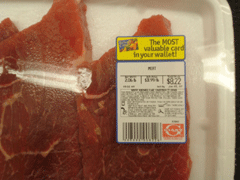
Mystery meat no more?
RANGAN: Lettuce will also when it’s bagged have a label on it, but it will not be if it’s in a bag with other greens in a mixed green salad.
GELLERMAN: Hmmm. Frozen peas.
RANGAN: Frozen peas yes in the box, they’ll have the label, but if its mixed with carrots or corn in any kind of veggie mix, it will not.
GELLERMAN: So, I don’t get it. What’s going on here? Why will some things have labels and some not?
RANGAN: It’s tricky. Generally single commodities that are in packages are going to be required to be labeled under this law. If they’re mixed, in general, that will be the exception and they won’t be required to be labeled. If a meat establishment doesn’t buy more than a quarter of a million dollars in produce, it’s also exempt.
GELLERMAN: But that’s an exception you could drive a herd through.
RANGAN: It is, and unfortunately it may have been created through something as simple as bad language copying. When the law was written for meat, for example, there was some legislation language lifted from a state law regarding produce, and so, what’s ended up in our law is that if a meat establishment doesn’t buy more that a quarter of a million dollars in produce, it’s also exempt.
GELLERMAN: Urvashi – I want to switch gears a little bit and talk about a label that’s not going to happen on food. The Food and Drug is proposing guidelines that wouldn’t require labels for genetically modified foods.
RANGAN: Well, the FDA is basically saying that producers can go ahead and manufacture genetically modified animals and sell their products without having to label them. We think that that lack of labeling on food products is really irresponsible frankly to the American public. And it’s a major method when you hear things like mouse genes put into pigs or spider genes put into goats. We think people have a right to know that the pig they’re buying might have had mouse genes. And this FDA action to undo that and basically to say that those products don’t have to be labeled really does a disservice to that information base for consumers.

Country-of-origin stickers indicate these apples are actually Kiwis.
GELLERMAN: Urvashi, I’m going to pretend I understand why you would want to put a mouse gene in a pig, but what about spider genes in goats?
RANGAN: Spider genes have been put into goats so that their milk will make spider silk, and that can then be harvested for a variety of different purposes. Mouse genes were put into pigs to help them metabolize phosphorus more efficiently. So genetic engineering goes on for such a wide array of purposes. We think no matter what the purpose, no matter why it was done, that at the very least people should have the information that something was modified in that product that they were buying.
GELLERMAN: So the consumer wouldn’t have to guess what’s coming for dinner.
RANGAN: [LAUGH] that’s right. The consumer should not have to guess what’s coming to dinner. And whether its labeling for genetic modification or country of origin, that gives the consumer more information about who’s coming to dinner.
GELLERMAN: Well, thanks a lot Urvashi. I really enjoyed it.
RANGAN: Thanks, Bruce, it’s good to be here.
GELLERMAN: Urvashi Rangan is with Consumers Union. For more information about food labels check out our label ww.loe.org.
Related links:
- To learn more about country of origin labeling, check out the Consumers Union’s “COOL Tool”
- To learn more about the FDA and genetically modified animals, click here
[MUSIC: Laurie Anderson “Big Science” from Talk Normal (Warner Archives 2000)]
Defending Coal’s Victims
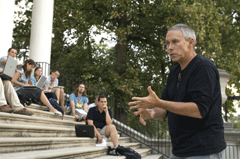
Thomas Fitzgerald is this year's Heinz Family foundation winner in the environment category. (Photo: John Nation/Heinz Awards)
GELLERMAN: T’is the season for awards. There were TV’s Emmy’s, the MacArthur genius awards and the Heinz Award for the Environment. The winner receives a quarter of a million dollars, making the Heinz one of the largest individual achievement prizes in the world.
This year Thomas FitzGerald is getting the check. He’s founder and director of the Kentucky Resources Council. There, he’s helped fashion environmental laws and has offered free legal services for people harmed by coal mining operations in the bluegrass state. Over the past 25 years, he’s been involved in hundreds of cases but there’s one that Thomas FitzGerald remembers best.
FITZGERALD: It was a tragedy. In 1979, there was a waste dam. The fine material that’s washed from the coal – its called slurry – they pumped this behind a face of coarse rock and slate and it collapsed at four in the morning and washed down into a very narrow valley and killed one of my clients. She was a 83 year old post mistress who had retired and she didn’t even know the waste dam was there. There were three separate agencies that were responsible for assuring that that dam was properly designed, constructed and inspected, and not one of the three had done their job. That case will always stand out in my mind, ‘cause Nellie was a wonderful woman and the idea of her being crushed to death by this wall of coal slurry is something that haunts me to this day.
GELLERMAN: In terms of this tragic case with Nellie and the dam, has anything changed as a result of your legal involvement.
FITZGERALD: I worked with the attorney that represented her sons’ estate, and they won a wrongful death case. In turn, the attorney and Nellie’s son Clark donated $5,000 to me, which was the beginning of the Kentucky Resources Council. Since Nellie’s death in ’79, there have been additional waste dam failures, but you know, the tools are there, in the ’77 mining law, to create more accountability on the part of the coal industry.
GELLERMAN: But I understand that you used a 1977 surface mining act in an unusual way – that there’s a little known part of the law that you used to great persuasion.

Thomas Fitzgerald is this year's Heinz Family foundation winner in the environment category. (Photo: John Nation/Heinz Awards)
GELLERMAN: So you were able to persuade the mining companies not to mine there, versus litigating which would have taken many, many years.
FITZGERALD: Well in this case, it actually wasn’t really persuading them as much as invoking a kind of – almost a land use provision. You know, the final one that – and I did mention – is we filed a petition to stop a mountain top removal operation over on Big Black Mountain which is the tallest mountain peak in the state and it’s one that has a northern forested ecosystem, even though we’re not in the north – it’s that high in elevation. And, through a negotiated process with the timber companies as well as the state of Kentucky, we were able to purchase the timber rights and to protect Big Black Mountain from the 3,000 foot elevation up, it can’t be minded or timber. So that was – that’s probably one of the more visible victories, because, you know, it’s the tallest peak in the state.
GELLERMAN: You’re something of an environmental hero nowadays, but I imagine that you’ve made quite a number of enemies down there in coal country.
FITZGERALD: There are a number of people who are – you know, would just as soon I lived in another state. It is a very frustrating for a lot of the folks who are employed in the industry who see the damage that’s being done to the land and the water resources. We’ve had some difficult times where workers are put in a difficult situation of being told that they will lose their jobs. You know, the industry, any time you ask them to internalize any of the costs of doing business, they will cry that they’re going to go out of business and it’s gonna costs jobs. And, you know, we’re ground zero for climate change. We’re 98 percent dependent on coal-fired power here in the state. We’re one of the poorest states in the union. So we’ve got our work cut out for us when it comes to coming to try to solve the energy issues and trying to move forward into a carbon constrained world.
GELLERMAN: You do most of your work – or all your work – pro bono, right? Free?
FITZGERALD: Yes. I’ve never billed a client in all the years that I’ve been practicing. We are set up to be a legal services, a legal aid and technical and strategy assistance provider. If people can afford a lawyer we send them somewhere else.
GELLERMAN: Well, did you get your quarter of a million dollar check from the Heinz Family Foundation yet?
FITZGERALD: No, I have not. Having been gainfully underemployed all these years, we do have some debt, and three boys in college, so I think that this could not have come at a more opportune time.
GELLERMAN: Well, Mr. FitzGerald, again congratulations and thank you very much.
FITZGERALD: Oh thank you. It’s a pleasure visiting with you.
Related links:
- Heinz Family Foundation
- Kentucky Resources Council
[MUSIC: Irma Thomas W/ Ellis Marsalis “This Bitter Earth” from Simply Grand (Rounder 2008)]
Your Environmental Road Trip
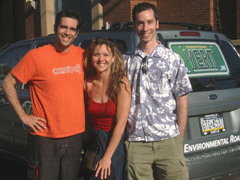
Ben Evan, Julie Evan, and Mark Dixon pose with "Rachel" the Ford Hybrid, named for Rachel Carson, they drove across the country.
GELLERMAN: The great American road trip is a rite of passage for a lot of young people. But it was more than the open road that Julie and Ben Evans and their friend Mark Dixon were driving for. They hit the highways and byways of America in search of strange and quirky stories about the environment and video’d the people and places they encountered.
They called their year-long, 50 state adventure YERT or Your Environmental Road Trip. Two out of three YERTers join me. In Louisville, Kentucky is Julie Evans. Hi, Julie.
EVANS: Hi
GELLERMAN: And in the studio is Mark Dixon. He’s the third in the trio. Hi Mark
DIXON: Hi there.
GELLERMAN: Well, you know, when I was watching your videos, I was thinking this is like Hunter Thomson meets Rachel Carson.
[LAUGHING]
GELLERMAN: Here you’re preaching the gospel of the environment by driving across the country, going to all these bizarre and weird places, but you’re driving nonetheless. It doesn’t sound eco friendly to me.

Ben Evans, Julie Evans, and Mark Dixon pose with "Rachel" the Ford Hybrid, named for Rachel Carson, they drove across the country.(Photo: Sean MacInnes)
DIXON: Yeah, it’s the first oxymoron that we hit upon. Actually, we looked at doing a bicycle road trip. It turns out that I have a weird knee that doesn’t like to bike. The car we chose was about as small as we could get and still hold all of our equipment.
GELLERMAN: It was a hybrid.
EVANS: Yeah, it was a Ford hybrid. And we thought maybe it’s another way to get more people onboard who don’t even know what a hybrid is.
GELLERMAN: Well, what were the rules of the road.
DIXON: The first was that we had to keep all of our garbage with us. We’re trying to make no more than one shoebox of garbage per month across all three of us.
GELLERMAN: You were able to do that?
DIXON: Yeah, essentially we were.
[LAUGHING]
EVANS: We crammed it.
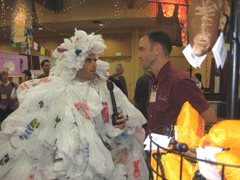
Ben Evans as the "Bag Monster" conducting an interview. (Photo: Julie Evans)
DIXON: Yeah, our feet were up by our heads. We actually started shipping home some of our less vital equipment and other things, other supplies, to make room for the garbage. You know, it was either garbage, or maybe your underwear.
EVANS: We really tried to plan ahead and have ways to kind of combat the garbage. And we talked to our waiters right when we sat down like “We’re doing an experiment. Please no straws, no napkins, no nothing.” And they mostly were really interested, so that was a huge help.
GELLERMAN: What are the other rules?
DIXON: Well, we also said we can’t turn on any incandescent light bulbs.
GELLERMAN: So were you in the dark quite a bit?
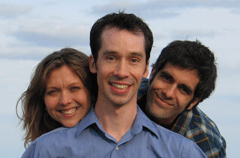
Julie Evans, Mark Dixon, and Ben Evans (Photo: Gregg Dixon)
DIXON: Yes, we were. And we used little LED headlamps. It made our hosts guilty a lot of the time. If they didn’t have a – if they didn’t have the right bulbs in their home, they would take one look at us sitting in the dark with our headlamps and feel so guilty that some of them would run out and buy compact fluorescents on the spot.
EVANS: We weren’t doing it to try to guilt anyone. We were just doing it for our own experiment. But it did sometimes turn out that way.
GELLERMAN: Where did the ideas for the stories come form? Did you just roll into town and say what’s strange, unusual weird about the environmental movement?
DIXON and EVANS: Sometimes.
[LAUGHING]
DIXON: Yeah, sometimes we would do just that.
EVANS: It’s a big country though, man. It is really huge. And there is so much going on.
GELLERMAN: You went to a town in Idaho, Elk Bend, I think it’s called. You met some very strange characters, living in some very strange circumstances.
DUG OUT DICK: I built that big rock house, down there.
EVANS: Yeah, that’s Dug Out Dick. He was a miner. He’s been living in a cave for about sixty years.
DUG OUT DICK: I built a house up here. They have to come up here to see me.
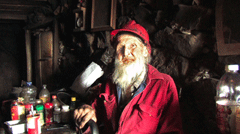
Dug Out Dick has been living in a cave in Elk Bend, Idaho for 60 years. (Photo: Ben Evans)
EVANS: He was looking for – looking for ore, didn’t really find it, but discovered that it was warmer in the cave than it was outside in the winter in Idaho. And so he actually furnished them. He went to dumps and he got wood stoves and he got mattresses and he made like - I don’t know – eleven or twelve little places where people could actually stay. And you could stay there for a dollar a night.
BRUCE: Look at me; I live in a cave. I’ve got everything you’ve got. I’ve got a comfortable chair. I’ve got a warm stove. I can cook, I can sleep, I can read.
EVANS: That’s Bruce. He’s lived there for several years and he pays his years in advance. I think its $300.
BRUCE: Progress, the way people look at it is all these great technological things, you know. But it’s really hurting the planet. What we really need to do is regress. Maybe grow gardens more than we do. Maybe live in a cave, you know.
GELLERMAN: Boy, it makes me want to head for the hills.
DIXON: It was some good living up there.
EVANS: Yeah, he loves it. He absolutely loves it. To him – you know – he still has a car. Bruce still has a car, and he goes to work and has a regular job.
GELLERMAN: Well, speaking of cars, let’s go to Salt Lake City Utah where you found national parking day.
EVANS: That happens all over the country I think. We just happened to hit it on the right weekend in Salt Lake City, I think.
[ROCK MUSIC]
WOMAN: And so it’s just a way to kinda raise awareness of the importance of parks by building one park at a time, one stall at a time, one dime at a time, or quarters now.
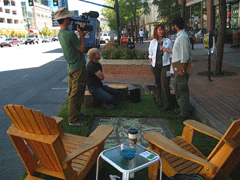
Mark Dixon films Ben Evans interviewing a park goer on parking day. (Photo: Julie Evans)
GELLERMAN: Well this is where people put some money into a meter and then that space becomes theirs and they don’t use it to park their cars. They can do whatever they want with that space.
DIXON: Oh yeah, they’ll put down some grass and maybe a park bench and a tree, and we played football in one of them.
EVANS: Croquet
DIXON: Yup, croquet too. It was a good time.
[ROCK MUSIC]
DIXON, EVANS: Utah, where all the streets are paved with grass.
[MUSIC ENDS]
GELLERMAN: Let’s listen to another clip. You went off to Iowa, Des Moines, I guess it was – for the corn challenge?
[MUSIC]
MAN: We call this the all corn, many corn, no corn challenge.
EVANS: oh right.
DIXON: Yes, our very own corn challenge.
[LAUGHING]
EVANS: That was Mark’s favorite week of digestion.
GELLERMAN: I guess you had to eat only corn products basically.
DIXON: Well just corn off the cob.
I really can actually understand how corn fed beef feels – crappy. I – I feel like crap.
EVANS: Yeah, he could only eat corn. Ben could eat corn, anything that had corn in it, anything at all that had corn in it.
GELLERMAN: That’s right. Your husband, Ben.
[MUSIC, CRUNCHING OF CHIPS BEING EATEN]
DIXON: Potato chips
BEN: hmmm.
DIXON: Relish
BEN: Yup, I’m really slumming it here dude. I don’t know how I’m going to make it through five whole days of eating 90% of what’s in the grocery store.
GELLERMAN: And you ….
EVANS: … could eat nothing that had corn.
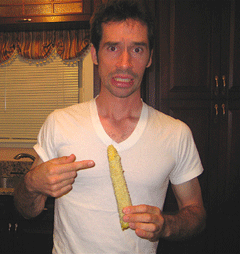
Mark Dixon ate only corn on the cob for 5 days as his part of the corn challenge. (Photo: Julie Evans)
[MUSIC]
EVANS: Corn challenge breakfast. Oops. Who would think that there’s corn in your yogurt. Corn syrup solids. Corn starch modified.
[MUSIC FADES]
EVANS: That’s when we discovered that most things have corn in them. Then suddenly I had to really, really read my labels. And that’s why I ended up eating mostly fresh fruit.
GELLERMAN: Why did you call it Your Environmental Road Trip, not, you know, Our Environmental Road Trip?
DIXON: We really wanted to make it a participatory event. We didn’t want it to be just about us. We wanted it to be about everybody, and for everybody to embrace both the root and the people we met and take it upon themselves to maybe make a different in their life.
EVANS: And we still want it to be inclusive, very much.
GELLERMAN: Well Julie, thank you very much.
EVANS: Thank you so much. It was a pleasure and honor.
GELLERMAN: And Mark, you too.
DIXON: Thank you. Had a great time.
GELLERMAN: Mark Dixon, and Julie Evans recently finished their, or should we say Your Environmental Road Trip, YERT. Julie’s husband Ben was home with their new baby. She was born during the trip. For a link to view YERT’s videos, go to our website loe.org
Related link:
Your Environmental Road Trip
[MUSIC: The Grateful Dead “Truckin” from American Beauty (Warner Records 1970)]
Coming up: cool asphalt paves the way to a cool planet. Keep your ear to the ground. It’s Living on Earth.
[MUSIC: McCoy Tyner: “Baba Drame” from Guitars (Half Note Records 2008)]
The Road to Better Air
GELLERMAN: It’s Living on Earth, I’m Bruce Gellerman. Just ahead: for peat’s sake, residents of a Scottish island say no to a wind farm. But first this Cool Fix for a Hot Planet from Sandra Larson.
[SOUND OF TRAFFIC, TRUCKS ROARING BY]
LARSON: Vehicles on the road are often blamed for unhealthy air and global warming. But what about the road itself?
It turns out asphalt – or at least the production of it – also emits unhealthy fumes and greenhouse gases.
[THEME MUSIC]
LARSON: Researchers at the National Center for Asphalt Testing, along with the Federal Highway Administration, are studying a new and more environmentally-friendly asphalt.
About 60 million tons of “hot mix asphalt” pave US roads every year. It’s made by mixing a sand and rock aggregate with a hydrocarbon liquid, and heating the brew to around 300 degrees. This energy-intensive process spews greenhouse gases and hazardous fumes.
European countries have developed a way to make asphalt at temperatures fifty to one hundred degrees lower. This “warm mix” process cuts carbon dioxide emissions by 30 to 40 percent and nitrous oxides by up to 70 percent. Dust and fumes are reduced, too - and it takes less fuel to make.
The U.S. researchers are studying how the pavement will hold up here under harsh temperatures and heavy use, and how to adapt the new process to larger manufacturing plants.
Last year, an experimental road was paved in Yellowstone Park using warm mix asphalt. And it’s in the plans for other projects, from highways in Texas to runways in Massachusetts. So it looks like warm asphalt is a hot prospect.
In the traffic jam of the future, you may be comforted to know that at least the road you’re stuck on is fuel-efficient.
That’s this week’s cool fix for a hot planet. I’m Sandra Larson.
Related links:
- The National Asphalt Pavement Association
- Warm Mix Asphalt Technologies and Research at The Federal Highway Administration
- The National Center for Asphalt Testing at Auburn University
- Boston Logan Airport to use WMA on runway project
GELLERMAN: And if you have a Cool Fix for a Hot Planet, we'd like to know it. If we use your idea on the air, we'll send you a sleek electric blue Living on Earth tire gauge. Keep your tires properly inflated and you could save over $500 a year in fuel. That’s according to a study done at Carnegie Mellon University. Call our listener line at 800-218-9988, that's 800-218-99-88. Or email coolfix—that's one word—at loe.org. That's coolfix@loe.org.
[MUSIC: The Iron Horse “ The Burning Of Auchindoun” from Folk ‘n Hell: Fiery New Music From Scotland (Hemisphere 1996)]
Scotching the Wind
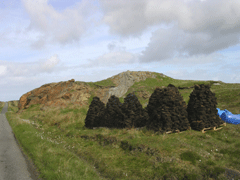
Peatstacks line the roadsides ready for collection. (Photo: Tom Allan)
GELLERMAN: Far in the northwest of Scotland, where the wind sweeps in from the sea, you’ll find the Isle of Lewis. Here, life is different. Traditions are long lived and run deep, woven like the tweed the island is known for. On Lewis, Sabbath psalms are sung in Gaelic. The place looks barren and tree-less but rare birds thrive on the wetlands, and a thin layer of grass and moss hide Lewis’ most valuable resource – peat. Dark and rich, the peat is the product of thousands of years of dead plants, layer upon layer, preserved in the marshy waters, dug up and burned as fuel. But proponents of a new source of energy – wind – hoped to build on the peat bogs and as Tom Allan found, they ran hard into the Isle of Lewis’ historic roots.
[CRACKLING OF COAL IN A FORGE AND THE SOUND OF ELECTRIC BELLOWS]
ALLAN: Seventy-four-year-old blacksmith Callum Macleod stands poised in the dark of his forge, waiting for the metal in the fire to glow white. His face is lit up by the embers, as the whirring electric bellows pours sparks into the air. Suddenly, he pulls the steel out of the fire, and onto the anvil.
[SOUND OF HAMMERING METAL]
ALLAN: He's making a Tarasgeir, the gaelic name for a peat iron – the heavy bladed pole used to cut peat.
MACLEOD: The hammering is hardening the metal, it's making the blade rigid.
[HAMMERING PAUSES]
MACLEOD: I reckon my father made at least six thousand in his time. And I know since I started I've made up to three thousand, all together.
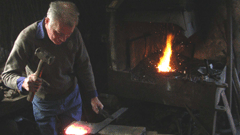
Callum Macleod forges a tarasgeir. (Photo: Tom Allan)
ALLAN: But orders for Callum's peat irons had dwindled in recent years - until this year, when they shot up.
MACLEOD: And they're still wanting ‘em.
ALLAN: And why do you think they've gone back up?
MACLEOD: Oh, well, the cost of fuel. The price of oil. The price of oil. If anybody has an open fire or a stove, it saves them a lot. The price of coal, even, and that it saves a lot of money just cutting a few peats to throw on the fire in the wintertime.
[RUSTY GATE OPENING AND FOOTSTEPS BEGINNING]
ALLAN: Ian Macintosh leads me up to the family peat banks on the edge of the moor above the town of Stornoway, the island’s diminutive capital. From up here the landscape is flat and unbroken, except for the exposed peatbanks, and the gentle roll of the Barvas hills in the distance.
[SOUND OF FOOTSTEPS AND BIRDSONG]
MACINTOSH: [LAUGHING] I'll probably be out of puff by the top of the hills.

Ian Macintosh loads his tractor with dried peats. (Photo: Tom Allan)
[FOOTSTEPS AND BIRDSONG CONTINUES]
ALLAN: It may look barren, but peatlands are incredibly important. They absorb and store vast quantities of carbon dioxide, helping to keep the planet's atmosphere in balance. Peatlands cover 3% of the earth's surface and are also an excellent home for birds and wildlife.
MACINTOSH: ...not sure what bird that is in the distance, I think we'd heard it earlier on.
ALLAN: Ian Macintosh, and his father before him, have cut the peat on this spot for fifty years. It's a bit like having your own coal mine – only the water soaked peat needs to be dried out before it can be burnt.
MACINTOSH: That's it.
ALLAN: Ian's already made some rows of neatly stacked peats, like small brown teepees.

Peatstacks line the roadsides ready for collection. (Photo: Tom Allan)
MACINTOSH: Here's me trying to remember where I've left the peat iron.
ALLAN: In return for a little help bagging the dry peats, he's going to show me how the cutting is done.
[MACINTOSH GIVING INSTRUCTIONS, LOTS OF ACTION]
MACINTOSH: You'll have one chap standing up here, and …
[SOUND OF STAMPING IN THE PEAT IRON]
MACINTOSH: … you kick the peat forward. It's a two man job, so the other person is down here. You'll have someone else waiting here to pick up the peat, and basically lay it like that. Stack them up, like so.
ALLAN: He lets me cut the second layer of peat. I stand on the bank, and push the broad blade down hard with my foot. The force isn't needed – the peat's soft and rich, almost like brown butter in texture. There's quite an art to the whole process. The depth of the cuts, the size and thickness of the pieces, and the exact way in which Ian stacks them, all contribute to getting a fine, dry peat for the fire.
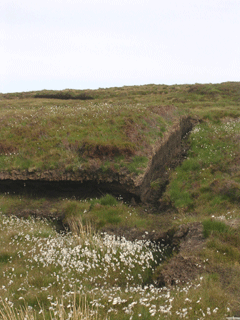
Peat banks mark the landscape on the island. (Photo: Tom Allan)
MACINTOSH: You have them standing in such a way that, well hopefully that they get the best of the wind and the sun. If you do it in that sort of shape, the wind goes through the tunnel thing there, and the sun dries on there.
[SOUND OF MACINTOSH PATTING THE PEAT]
MACINTOSH: That's them drying, and basically that's them waiting to just dry, bagged and home.
[SOUND OF BAGGING AND TRACTOR]
ALLAN: He also impresses upon me how important it is to look after the land – to replace the living layer of grass where the peat has been removed, and to cut the banks at an angle, so that they don't cave in. If you get it right, the turf is good as new in a couple of years, and the remaining peat is protected from the elements.
As we bag the dry peats, and wait for Ian's tractor, we spot another tractor on the horizon loading its own crop. It's the first time that he's seen anyone working this part of the moor in years.
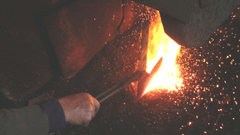
The heat of the forge. (Photo: Tom Allan)
MACINTOSH: At one time when I was youngster, every household used to do it because it was the only fuel that was available to people. Very often in a croft house you would have maybe a stove in the kitchen, which was used for cooking and heating the place, and was fueled purely by peat.
ALLAN: But Ian reckons that in recent years as few as a hundred people were still cutting, on an island of nearly nineteen thousand – the tradition was dying out.
MACINTOSH: Over the years of course, with oil becoming available and everyone getting central heating, almost everybody stopped doing peat, except for perhaps a few enthusiasts. But there could be a resurgence -- and when you think of it, a bit of exercise, fresh air...and you've got something to show at the end of it. If you go out jogging you don't come back with a bag of fuel on you're back! [LAUGHING]
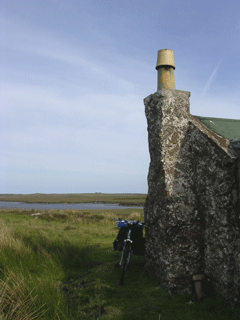
The Isle of Lewis. (Photo: Tom Allan)
[SOUND OF WASHING BOOTS AND STREAM]
ALLAN: I catch Joan and Bernard Chisholm washing their rubber boots in a stream after a few hours peat cutting. They tell me that they're cutting more this year to help pay the bills.
JEAN CHISOLM: Oh yes, this year, definitely. The peat doesn't cost us anything, plus we'll get our heating, our cooking, and our hot water. So you're getting all these three things and it didn't cost you anything, really, to get it.
BERNARD CHISOLM: A lot of people are coming out purely because of the price, and because it's available, and it costs nothing but your labor. And it's still available to all the wildlife that uses it, it's still available to the people, and it still looks good.
[SOUND OF CYCLING, GEARS CHANGING, HEAVY BREATHING]
ALLAN: I'm cycling away from Stornoway now, over the moor. Everywhere you look, you can see signs of the peat cuttings...a lot of the cuttings appear to be abandoned, unused, but there's also a fair few with the piles of peat waiting and ready to be collected…. But if I stop here …
[SOUND OF BRAKES]
ALLAN: … and look, and look to my left, you can kind of see the future of energy on this island as well, because in the distance, on the coast, I can see the island’s first three wind turbines.
[SOUND OF GENTLE WIND FADES INTO THE ROAR OF WIND TURBINES]
ALLAN: The conditions that make the island perfect for peat, also make it perfect for wind power – the strong winds that roar in from the Atlantic could generate enough electricity for more than half a million homes on the British mainland. That potential looked set to become a reality, when, four years ago, plans for the world's largest wind-farm were put forward by Lewis Wind Power, a consortium of British Energy and Amec.
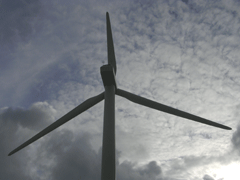
One of the new wind turbines on the Isle of Lewis. (Photo: Tom Allan)
ANGUS CAMPBELL: As far back as the year 2000 we recognized the huge potential for wind power and other renewable energies in the Western Isles. In fact. we saw it as the one economic driver that would change the economy of the Western Isles.
ALLAN: Angus Campbell of the Western Isles Council is a strong advocate of wind power, for the jobs and investment it would bring to the fragile economy of the island.
ANGUS CAMPBELL: At the moment we're looking at anything up to a gigawatt of onshore wind, something like a seventh of Scotland's whole energy needs. I'm not a technical man, but it's certainly an awful lot of energy. To put it in perspective, we only, on this island, use about 20 megawatts ourselves.
ALLAN: The project would have seen 181 turbines, each 460 feet high, spring up on the island, connected back to the mainland by a giant underwater cable – a renewable energy pipeline. It would have created around six hundred jobs, and pumped millions of dollars into the island’s economy.
But in May, the plans were rejected by the Scottish Government. The Lewis Peatlands are protected for their rare birdlife, such as the dunline, golden plover, greenshank and golden eagle. For Angus Campbell, that's putting birds before people.
ANGUS CAMPBELL: Well, it's been a huge blow to us in terms of the number of jobs we hoped to create and the number of people we thought it would support living here. If a species appears on the Barvas moors, you suddenly get a huge amount of protection. But there is very little protection for the local inhabitants that are living here and looking for work. People just don't seem to have come into this argument.
ALLAN: How did the islanders really feel about the development? A poll in 2005 showed opinion running two to one against the proposal; letters ran even more heavily against, more than 100 to one. The strongest objections came from those who feared it would end their way of life.
[SOUND OF WIND]
CATRIONA CAMPBELL: My name’s Catriona Campbell, Catriona Winehisaq in Gaelic, I’m from the village of Braga on the Ilse of Lewis.
ALLAN: Catriona Campbell tells me her Gaelic name because she wants people to understand that she's a native of the island, not some newcomer with a bee in her bonnet. Standing on the edge of her village, she points to where the wind farm would have stood.
CATRIONA CAMPBELL: Our peats are about three quarters of an hour that way, three quarters of an hour walk that is. And that's where they were proposing to put the turbines, right on top of our village peat banks. This is one of the largest pieces of intact blanket bog in Europe. My own wee daughter was out there paddling in a peat pool, a pool of damp peat, and she asked me, "I wonder if my granny did this?", and I said to her, "I know you're granny did that when she was a small child, and her granny before her. And I thought, but your grandchildren won't if this wind farm goes ahead, because it'll be concrete.
ALLAN: Catriona Campbell formed Moorland without Turbines, and they soon learnt that there were scientific, as well as personal reasons, to oppose the wind farm.
LINDSAY: Peatlands contain something like three to three-and-a-half times the amount of carbon as is stored in the tropical rainforests.
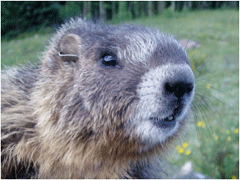
(Photo: Dr. Daniel T. Blumstein, UCLA)
ALLAN: Richard Lindsay is head of the Environmental Research Group at the University of East London. For twenty years he worked for the Government Wildlife Service as its peatlands specialist. He fears that in our rush to build wind farms in Europe's windiest places, we may end up releasing nearly as much carbon dioxide as conventional coal or gas power stations; because when you dig up or drain peatland, you begin to release the vast quantities of carbon stored in it.
LINDSAY: It's the roads that are the major issue with the wind farms. They cut across the peatland, they break up the flow of water – that is the major impact of wind farms on peat.
ALLAN: The Lewis project alone would have needed a hundred miles of access roads, and disturbed some 50 million cubic yards of peat -- making the small amounts that the islanders cut and burn seem pretty insignificant.
LINDSAY: If, in thirty years’ time, we look back and we say, “well, they did produce a lot more carbon than we expected,” then there's been this huge amount of industrial development, there's been this huge amount of landscape disruption, for very little gain.
ALLAN: Lewis Wind Power estimated that it would only take four and a half months for the working wind farm to “pay back” the carbon it released from the peat, by reducing the need for dirtier power. And a recent report commissioned by the Scottish Government suggests that wind farms built on peatland can repay all their carbon costs – including construction, installation, decommissioning and disruption of peatland – in just three years. But both estimates depend on the peat being successfully restored, and Lindsay says that that isn't so simple.
LINDSAY: Peat developed in a very very particular way, it develops very slowly over thousands of years. When developers say, "oh, we can just restore peat, we can bulldoze the peat back into the old quarries and drain lines, and so on, and then we'll just cover it over with bog vegetation, and that’s it, solved” -- there is no way that moving the peat around in that way is going to recreate the very special structure of peat. When you've damaged it you can't restore the structure.
ALLAN: Richard Lindsay says people can see and identify with rain forests and trees, and understand their importance. But they see peatland as empty space, with no practical purpose.
LINDSAY: In prehistoric times it was obviously regarded as a very sacred, special place. Really very expensive items, bronze statues, were placed as votive offerings into the bog. We've utterly lost that. Now Western cultures really have a total blind spot when it comes to peatlands, because they're seen as economically worthless.
ALLAN: But on Lewis, where life and tradition are still linked to the land, people understand how important and delicate the peatlands are. Again, Catriona Campbell:
CATRIONA CAMPBELL: For thousands of years it's been used by the people who live here – you know, we're the indigenous people. We have a very long association with our peat banks. We go back year after year to the same place. We just felt that it was an insult to us to come in and expect to take them away from us without even asking our permission.
[SOUNDS OF WALKING AWAY]
ALLAN: And perhaps the sight of those freshly cut peat banks, the sound of Tarasgeirs being forged, and the tales of paddling about in pools of damp peat, can help remind us that there is something important underneath the turf after all.
For Living On Earth, I'm Tom Allan.
[MUSIC: Fergus MacKenzie/Simon Thoumire “By The Right” from Folk ‘n Hell: Fiery New Music From Scotland (Hemisphere 1996)]
GELLERMAN: On the next Living on Earth – From narcotics to antibiotics, Americans are dumping an estimated quarter of a billion pounds of drugs down the drain. All unregulated.
GRUMBLES: The toilet is not a trashcan. The most important thing right now is to be spreading the word about proper disposal of pharmaceuticals.
GELLERMAN: Drugs that are flushed out of sight are now very much on the minds of federal officials - Next time on Living on Earth.
GELLERMAN: Living on Earth is produced by the World Media Foundation. Our crew includes Ashley Ahearn, Bobby Bascomb, Eileen Bolinsky, Ingrid Lobet, Helen Palmer, Mitra Taj and Jeff Young, with help from Sarah Calkins and Marilyn Govoni. Our interns are Sandra Larson and Jessie Martin.
Jeff Turton is our technical director. Alison Lirish Dean composed our themes. Steve Curwood is our executive producer. You can find us at LOE dot org.
I’m Bruce Gellerman. Thanks for listening.
ANNOUNCER: Funding for Living on Earth comes from the National Science Foundation, supporting coverage of emerging science, and Stonyfield Farm: organic yogurt and smoothies. Stonyfield pays its farmers not to use artificial growth hormones on their cows. Details at stonyfield.com.
Support also comes from you our listeners, the Ford Foundation, the Town Creek Foundation, and the Oak Foundation supporting coverage of climate change and marine issues; The Rockefeller Foundation and its Campaign for American Workers. More at rockfound dot org. And Pax World Mutual Funds: socially and environmentally sustainable investing. Pax World: for tomorrow. On the web at paxworld.com.
ANNOUNCER: PRI, Public Radio International.
Living on Earth wants to hear from you!
Living on Earth
62 Calef Highway, Suite 212
Lee, NH 03861
Telephone: 617-287-4121
E-mail: comments@loe.org
Newsletter [Click here]
Donate to Living on Earth!
Living on Earth is an independent media program and relies entirely on contributions from listeners and institutions supporting public service. Please donate now to preserve an independent environmental voice.
NewsletterLiving on Earth offers a weekly delivery of the show's rundown to your mailbox. Sign up for our newsletter today!
 Sailors For The Sea: Be the change you want to sea.
Sailors For The Sea: Be the change you want to sea.
 The Grantham Foundation for the Protection of the Environment: Committed to protecting and improving the health of the global environment.
The Grantham Foundation for the Protection of the Environment: Committed to protecting and improving the health of the global environment.
 Contribute to Living on Earth and receive, as our gift to you, an archival print of one of Mark Seth Lender's extraordinary wildlife photographs. Follow the link to see Mark's current collection of photographs.
Contribute to Living on Earth and receive, as our gift to you, an archival print of one of Mark Seth Lender's extraordinary wildlife photographs. Follow the link to see Mark's current collection of photographs.
 Buy a signed copy of Mark Seth Lender's book Smeagull the Seagull & support Living on Earth
Buy a signed copy of Mark Seth Lender's book Smeagull the Seagull & support Living on Earth

